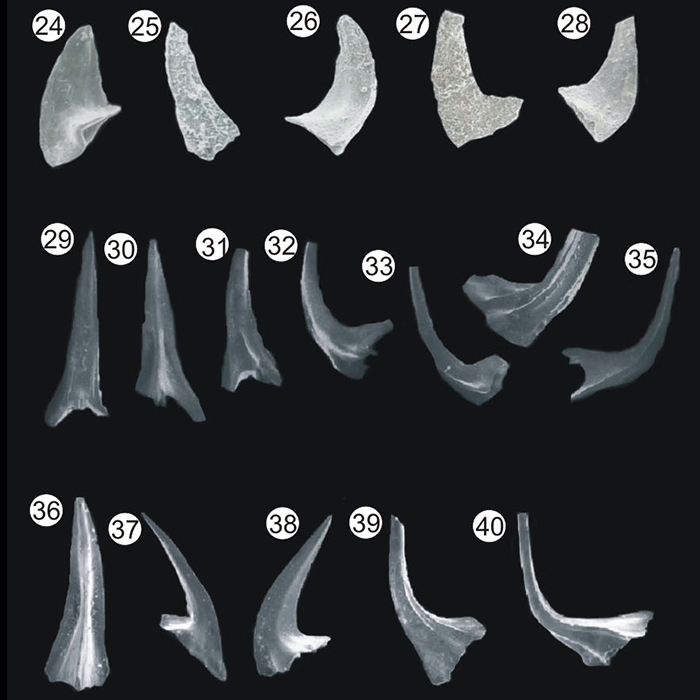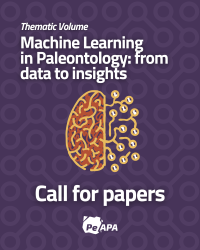THE ORDOVICIAN CONODONT TRIPODUS LAEVIS BRADSHAW, 1969: ITS TAXONOMIC VALIDITY AND BIOSTRATIGRAPHIC VALUE IN THE ARGENTINE PRECORDILLERA
DOI:
https://doi.org/10.5710/PEAPA.09.04.2024.489Keywords:
Dapingian, Conodont, Argentina, PrecordilleraAbstract
The conodont species Tripodus laevis has been used as an index conodont to mark the lower boundary of the Middle Ordovician in the Midcontinent and Precordillera conodont biostratigraphic charts, despite that T. laevis or specimens assignable to this species span from
lower Floian to middle Darriwilian. Also, this conodont species has a complex taxonomic history. It has been located in different conodont families and its apparatus has been composed of varying conodont morphotypes. In the present contribution, we conducted a critical revision of the taxonomic history of T. laevis, as well as its biostratigraphic value as a key species for indicating the lower boundary of the Dapingian stage. Based on this analysis, we propose that T. laevis sensu lato (s. l.) should not be considered a valid species and to avoid using this species for the Argentine Precordillera. Therefore, we suggest discontinuing the first appearance datum of T. laevis s. l. as a marker for the lower boundary of the Middle Ordovician in this region. In light of this proposal, we suggest using a new Dapingian conodont biostratigraphic chart for the Argentine Precordillera.
References
Albanesi, G. L. (1998). Taxonomía de conodontes de las secuencias Ordovícicas del cerro Potrerillo, Precordillera Central de San Juan, R. Argentina. Actas de la Academia Nacional de Ciencias, Córdoba, Argentina. XII, 101–252.
Albanesi, G.L. & Ortega, G. 2002. Advances on conodont-graptolite biostratigraphy of the Ordovician System in Argentina. In Aceñolaza, F.G. (Ed.) Aspects on the Ordovician System in Argentina. (143-165) Serie Correlación Geológica, No. 16, Instituto Superior de Correlación Geológica, Tucumán.
Albanesi, G. L. & Ortega, G. (2016). Conodont and Graptolite Biostratigraphy of the Ordovician System of Argentina. In Montenari, M. (Ed.), Stratigraphy & Timescales, (61–121). ISBN: 9780128115497
Albanesi, G., Hünicken, M. & Barnes, C. (1998). Bioestratigrafía de conodontes de las secuencias ordovícicas del Cerro Potrerillo, Precordillera Central de San Juan, R. Argentina. Academia Nacional de Ciencias, Córdoba, Argentina XII, 1–72.
Albanesi, G., Ortega, G., Barnes, C. & Hünicken, M. (1999). Conodont-graptolite biostratigraphy of the Gualcamayo Formation (Middle Ordovician) in the Gualcamayo-Guandacol rivers area, Argentina Precordillera. In Kraft P. & Fatka O. (Eds.). QuoVadis Ordovician? Short papers of the 8th International Symposium on the Ordovician System, Prague (43 (1/2): 45–48). Acta Univesitatis Carolinae – Geologica.
Albanesi, G., Carrera, M., Cañas, F. & Saltzman, M. (2006a). A proposed Global Boundary Stratotype Section and Point for the base of the Middle Ordovician Series: The Niquivil section, Precordillera of San Juan, Argentina. Episodes, Beijing, 29 (1), 1–15.
Albanesi, G., Voldman, G. & Ortega, G. (2006b). Control ambiental en la distribución de conodontes de la Zona de Lenodus variabilis (Darriwiliano) en la Precordillera del oeste argentino. 9° Congreso Argentino de Paleontología y Bioestratigrafía, 1–127.
Albanesi, G., Hünicken, M. & Barnes, C. (1998). Bioestratigrafía de conodontes de las secuencias ordovícicas del Cerro Potrerillo, Precordillera Central de San Juan, R. Argentina. Academia Nacional de Ciencias, Córdoba, XII, 1–72.
Bradshaw, L. E. (1969). Conodonts from the Fort Peña Formation (Middle Ordovician) Marathon Basin, Texas. Journal of Paleontology 43, 1137–1168.
Barnes, C. R. & Poplawski, M. L. S. (1973). Lower and Middle Ordovician conodonts from the Mystic Formation, Quebec, Canada: Journal of Paleontology, 47, 760–790.
Bauer, J. A. (2010). Conodonts and conodont biostratigraphy of the Joins and Oil Creek Formations, Arbuckle Mountains, south-central Oklahoma. Oklahoma Geological Survey Bulletin 150, 1–51.
Della Costa, G. & Albanesi, G. (2016). Bioestratigrafía de conodontes floianos y dapingianos (Ordovícico Inferior-Medio) de la Formación San Juan en la localidad de Peña Sombría, Precordillera de La Rioja. Congreso de la Asociación Paleontológica Argentina, Resumen: p. 38. Río Negro.
Ethington, R. L. & Clark, D. L. (1981). Lower and Middle Ordovician conodonts from the Ibex area, western Millard County, Utah. Brigham Young University Geology Studies, 28, 1–155.
Finney, S. C. & Ethington, R. L. (2000). Global Ordovician Series boundaries and global event horizons, Monitor Range and Roberts Mountains, Nevada. In Legeson, D. R., Peters, S. G., & Lahern, M. M. (Eds.), Great Basin and Sierra Nevada. Boulder, Cororado (301–318). Geological Society of America, Field Guide 2.
Finney, S. C. & Ethington, R. L. (2001). The Whiterock Narrows section, Monitor Range, Nevada: proposed as GSSP for base of Middle Ordovician Series (Report). In SOS, IUGS (Eds.) Internet web.
Heredia, S., Mestre, A. & Kaufmann, C. (2017). The Darriwilian conodont biostratigraphy from the Argentine Precordillera. In Liao, J-C. and Valenzuela-Rios, J. I. (Eds.). Progress on Conodonts Investigation. Cuaderno de Museo Geominero (22, 65–69). 4° International Conodont Symposium.
Johnston, D. I. & Barnes, C. R. (2000). Early and Middle Ordovician (Arenig) conodonts from St. Pauls Inlet and Martin Point, Cow Head Group, western Newfoundland, Canada. 2. Systematic Paleontology. Geologica et Paleontologica 34, 11–87.
Kennedy, D. J. (1980). A restudy of conodonts described by Branson & Mehl, 1933, from the Jefferson City Formation, Lower Ordovician, Missouri. Geological et Paleontologica, 14, 45–76.
Lehnert, O. (1995). Ordovizische Conodonten aus der Präkordillere Westargentiniens: Ihre Bedeutung für Stratigraphie und Paläogeographie. Erlangen geologische Abhandlungen, Erlangen, 125, 1–193.
Lindström, M. (1977): Genus Acodus Pander, 1856; Genus Paltodus Pander, 1856. In: Ziegler, W. (Ed.), Catalogue of Conodonts, (3: 1–20, 415–433); Stuttgart (Schweizerbart).
Loch, J. & Ethington, R. (2017). An integrated trilobite and conodont biostratigraphy across the base of the Laurentian Whiterockian Series (lower Middle Ordovician) at its stratotype, Whiterock Canyon Narrows, Nevada. Journal of Paleontology, 1–24. doi: 10.1017/jpa.2016.127
Löfgren, A., Viira, V. & Mens, K. (2005): Conodont biostratigraphy and sedimentary history in the upper Tremadoc at Uuga, Cape Pakri, NW Estonia. GFF, 127(4), 283-293.
Maletz, J. (2005). Early Middle Ordovician graptolite biostratigraphy of the Lovisefred and Albjära drill cores (Scania, southern Sweden). Palaontology, 48(4), 763–780.
Mango, M. & Albanesi, G. (2018a). Conodont biostratigraphy from the upper San Juan Formation (Middle Ordovician) at Niquivil, Argentine Precordillera. Journal of South American Earth Sciences. Volume 84: 48–55. https://doi.org/10.1016/j.jsames.2018.03.008.
Mango, M. & Albanesi, G. (2018b). Bioestratigrafía y provincialismo de conodontes del tramo medio-superior de la Formación San Juan en el cerro Viejo de Huaco, Precordillera, Argentina. Andean Geology 45 (2): 274–299. http://dx.doi.org/10.5027/andgeov45n2-3056.
Mango, M. & Albanesi, G. (2020). Conodont biostratigraphy and correlation of the San Juan Formation at the Cerro La Silla section, middle Tremadocian-lower Dapingian, Central Precordillera, Argentina. Andean Geology 47 (3): 577–598. http://dx.doi.org/10.5027/andgeoV47n3-3271.
Mango, M. & Albanesi, G. (2023). The Baltoniodus navis Zone in the Gualcamayo Formation (Middle Ordovician), Central Precordillera, Argentina. Journal of South American Earth Sciences, 126, https://doi.org/10.1016/j.jsames.2023.104332.
Moreno, F. (2023). Bioestratigrafía de conodontes del Dapingiano – Darriwiliano en la sección Talacasto - Quebrada Ancha, Precordillera Central. Serie de Correlación Geológica. 39 (1), 36–42. http://dx.doi.org/10.5281/zenodo.7926886.
McTavish, R. A. (1973). Prioniodontacean conodonts from the Emanuel Formation (Lower Ordovician) of Western Australia. Geologica et Palaeontologica 7, 27–58.
Mitchell, C. E. (2001). New graptolites collection from the proposed Whiterock global stratotype section: implications for correlation of the Narrows section and an alternative proposal for the location of the Middle Ordovician GSSP level. In SOS, IUGS (eds.) Internet web.
Ross, R. J. Jr., Hintze, L. F., Ethington, R. L., Miller, J. F., Taylor, M. E., & Repetski, J. E. (1997). The Ibexian, lowermost series in the North American Ordovician: United States Geological Survey Professional Paper 1579A, A1–A50.
Sarmiento, G., 1990. Conodontos ordovícicos de Argentina. Treballs del Museu de Geología 1, 135-161.
Serpagli, E. (1974). Lower Ordovician conodonts from Precordilleran Argentina (Province of San Juan). Bollettino della Società Paleontologica Italiana 13, 17–98.
Soria, T. (2017). La Zona de Oepikodus intermedius (Ordovícico Inferior) en la Quebrada Los Sapitos, Precordillera Central, San Juan. In Benedetto, L., Heredia, S., Aceñolaza, G. & Carlorosi, J. (Eds.). Estratigrafía y Paleontología del Paleozoico Inferior de Argentina, (32-37). XX Congreso Geológico Argentino, Tucumán.
Stouge, S. (1984). Conodonts of the Middle Ordovician Table Head Formation, western Newfoundland. Fossils and Strata, 16, 1–145.
Stouge, S. (2012). Middle Ordovician (late Dapingian-Darriwilian) conodonts from the Cow Head Group and Lower Head Formation, western Newfoundland, Canada. Canadian Journal Earth Sciences 49, 59–90. https://doi.org/10.1139/e11-057.
Stouge, S. & Bagnoli, G. (1988). Early Ordovician conodonts from the Cow Head Peninsula, western Newfoundland. Palaeontographica Italica 75, 89–179.
Sweet, W. C. (1988). The conodonta: morphology, taxonomy, paleoecology, and evolutionary history of a long extinct animal phylum. Oxford Monographs on Geology and Geophysics, 10, 212 (Oxford University Press, Oxford).
Sweet, W. C., Ethington, R. L. & Harris, A. G. (2005). A conodont-based standard reference section in central Nevada for the lower Middle Ordovician Whiterockian Series: Bulletins of American Paleontology, 369, 35–52.
Wang, X., Li, Z., Chen, X., & Wang, C. (2003). The Huanghuachang section, potential as Global stratotype for the base of the Middle Ordovician Series. In Albanesi G.L., Beresi M.S. and Peralta S.H. (Eds). Ordovician from Andes. INSUGEO, Serie Correlación Geológica, 17: 153-159.
Wang, X. F., Stouge, S., Chen, X. H., Li, Z. H., Wang, C. S., Finney, S. C., Zeng, Q. L., Zhou, Z. Q., Chen, H. M., Zhang, M., Xu, G. H. & Erdtmann, B.-D. (2009). The global stratotype section and point for the Middle Ordovician Series and the Third Stage (Dapingian). Episodes, 32 (2), 96–114.
Webby, B. D. (1998). Steps toward a global standard for Ordovician stratigraphy. Newsletter Stratigraphy, 36, 1–33.
Zhen, Y. Y., Liu, J. B. & Percival I. G. (2005). Revision of two prioniodontid species (Conodonta) from the Early Ordovician Honghuayuan Formation of Guizhou, South China. Records of the Australian Museum, 57 (2), 303–320.

Additional Files
Published
Issue
Section
License
Copyright (c) 2024 Ana Mestre, Florencia Moreno, Susana Heredia

This work is licensed under a Creative Commons Attribution-NoDerivatives 4.0 International License.
Authors retain copyright and grant the journal right of first publication with the work simultaneously licensed under a Atribución/Reconocimiento 4.0 Internacional that allows others to share the work with an acknowledgement of the work's authorship and initial publication in this journal.
















